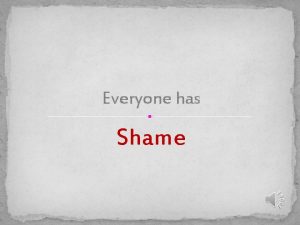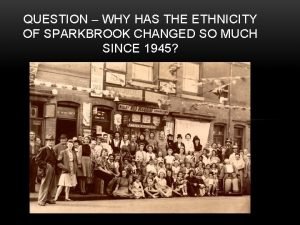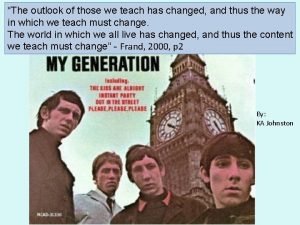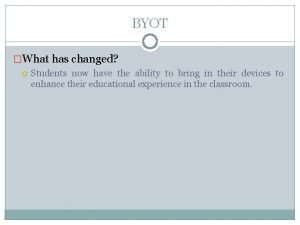How has the UK education system changed Types

























- Slides: 25

How has the UK education system changed?

Types of school in the UK Produce a short presentation about one of the types of school Types of school: 1. Community schools 2. Foundation schools 3. Academies (Traditional / OLD) 4. Academies (NEW) 5. Faith Schools 6. Free Schools 7. City technology colleges 8. State boarding schools 9. Private (/independent/public) schools 10. Special schools 11. Grammar Schools For each try to find out: — The curriculum; — The students (admissions) — How they are paid for — Governance — Accountability — An example of this type of school https: //www. gov. uk/types-of-school/overview http: //www. newschoolsnetwork. org/sites/default/files/pdf/Differences%20 across%20 scho ol%20 types. pdf

Community Schools Faith Schools Private schools Free Schools Academies (OLD) City Technology Colleges

Foundation schools Academies (NEW) State Boarding Schools Grammar Schools Special Schools

What are the advantages and disadvantages of having so many different school types? Advantages Disadvantages

The New Right’s View of Education Underlying principles of the New Right They believe the state (government) cannot meet people’s needs. The most efficient way to meet people’s needs is through the free market – through private businesses competing with each other. Economic growth is an important overall goal – to be achieved by allowing individuals the freedom to compete with each other. Key ideas of The New Right on Education- The New Right created an ‘education market’ – Schools were run like businesses – competing with each other for pupils and parents were given the choice over which school they send their children to rather than being limited to the local school in their catchment area. This lead to the establishment of league tables Schools should teach subjects that prepare pupils for work, Hence education should be aimed at supporting economic growth. Hence: New Vocationalism! The state was to provide a framework in order to ensure that schools were all teaching the same thing and transmitting the same shared values – hence the National Curriculum Social Democratic Views Covers a broad range of views and elements can be found in Labour, Lib. Dem and even Conservative policies. Underlying principles of Social Democracy: Social Democracy though is a middle way between the free market right and the socialist left. It advocates a mixed economy and believes the state should help the poor and disadvantaged and act like a referee - ensuring people and society stick to the rules and behave properly. There is a desire for meritocracy, but recognises that the system as it stands is unable to deliver. Social democrats believe that it is possible to work within the capitalism to create a fairer system. However they still argue that some inequality of outcome is inevitable and desirable. Key ideas of Social Democrats on Education - In education policy this has meant - providing state schools and free education for all, giving extra resources and help to those who need it. Providing grants and help for able pupils who cannot afford fee paying educational institutions, whether they be schools or establishments of higher education. Halsey argued that the grammar-school system disadvantaged working- class children. The 11+ exam tested middle-class culture and falsely labellled working-class children as less intelligent. Social democrats beleived that the tripartite system should be abolished and replaced by the comprehensive system. 1960 s 1979 -1997 -2010 -201… Labour introduced comprehensiv e education Conservative Labour Influenced by New Right mainly Influenced by BOTH New Right and Social Democrats 2010 -2015 coalition with Conservative and Lib Dems 2015 -present Conservative

Education and social policy The key aims of the political parties has been (variously) to achieve the following: - Competition, diversity and choice - Raising standards - Equality and equality of opportunity Identify policies that attempted to achieve each of these objectives. For each policy identify the following (where possible): - Date - Detail - How it reflects New Right / Social Democrat policy - Evidence of success / failure

Key policy: 1988 Education Reform Act This is one of the most important pieces of educational legislation. It led to significant changes to the purpose, structure and delivery of education. You may be asked questions about how far the aims of the act have been met.


Conservatives 1979 -1997 Competition Diversity & Choice Raising standards Equality & Equality of Opps


Conservatives 1979 -1997 Evaluation:

Labour 1997 -2010 Competition Diversity & Choice Raising standards Equality & Equality of Opps


Labour 1997 -2010 Evaluation:

Conservatives 2010 -present Competition Diversity & Choice Raising standards Equality & Equality of Opps


Conservatives 2010 -present Evaluation:

Competition, Diversity and Choice

Raising standards

Equality and Equality of Opportunity

Social Class Evidence of positive impact Evidence of limited impact

Gender Evidence of positive impact Evidence of limited impact

Ethnicity Evidence of positive impact Evidence of limited impact

Exam questions to answer: 1. In what ways does a child’s ethnicity influence his or her educational attainment? 10 marks 2. To what extent are boys now under achieving in education compared to girls? 20 marks 3. Assess the extent to which policies of marketisation of education have helped to improve educational opportunities for all children. 40 marks
 What does the picture depict
What does the picture depict The metamorphosis setting
The metamorphosis setting How has macbeth changed since act 1
How has macbeth changed since act 1 How has technology changed sports
How has technology changed sports Dave grolsh
Dave grolsh Has the exchange rate changed chapter 10
Has the exchange rate changed chapter 10 Has the exchange rate changed chapter 10
Has the exchange rate changed chapter 10 Hát kết hợp bộ gõ cơ thể
Hát kết hợp bộ gõ cơ thể Bổ thể
Bổ thể Tỉ lệ cơ thể trẻ em
Tỉ lệ cơ thể trẻ em Chó sói
Chó sói Chụp phim tư thế worms-breton
Chụp phim tư thế worms-breton Chúa yêu trần thế
Chúa yêu trần thế Các môn thể thao bắt đầu bằng tiếng nhảy
Các môn thể thao bắt đầu bằng tiếng nhảy Thế nào là hệ số cao nhất
Thế nào là hệ số cao nhất Các châu lục và đại dương trên thế giới
Các châu lục và đại dương trên thế giới Cong thức tính động năng
Cong thức tính động năng Trời xanh đây là của chúng ta thể thơ
Trời xanh đây là của chúng ta thể thơ Mật thư anh em như thể tay chân
Mật thư anh em như thể tay chân Phép trừ bù
Phép trừ bù độ dài liên kết
độ dài liên kết Các châu lục và đại dương trên thế giới
Các châu lục và đại dương trên thế giới Thơ thất ngôn tứ tuyệt đường luật
Thơ thất ngôn tứ tuyệt đường luật Quá trình desamine hóa có thể tạo ra
Quá trình desamine hóa có thể tạo ra Một số thể thơ truyền thống
Một số thể thơ truyền thống
















































